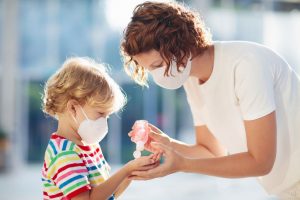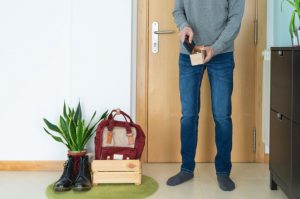Working with COVID-19 patients is stressful enough, and the extra-long shifts that many nurses have been pulling as medical facilities have been stretched close to the breaking point just adds to it. But none of it compares to the level of terror that comes after the shift, when it’s time to go home to loved ones… and to make sure that the virus does not go home with you.
The basic steps you can take to protect your loved ones are:
- Stay separated from family members:
- Live apart (hotel, hospital dorms) if possible
- Maintain separation within common areas of the house
- Reduce the amount of material traveling back and forth to work that could carry infectious fomites with you.
- Go through regular decontamination procedures when leaving work and when arriving home:
- Doff and separate work clothes
- Sanitize hands and shower
- Decontaminate personal items
- Regularly clean surfaces at home with EPA-approved disinfectants.
Family Safety Requires Cutting Potential Transmission Vectors
Understanding how to keep your family safe requires understanding how the SARS-CoV-2 virus propagates.
So far, the best available evidence from WHO indicates that SARS-CoV-2 is primarily transmitted from person to person through respiratory droplets and direct contacts.
That means the first priority is to ensure that you, yourself, do not become infected. While it’s possible for the virus to spread via fomite transmission, with particles carried on your clothes and personal effects, it’s thought to be extremely rare. The greatest risk comes from the virus culturing itself, reproducing, and spreading using your own body as the engine.
That means that even the most thorough decontamination process is addressing a relatively minor threat. The main risk to your family is you, should you become infected and become an incubation factory for the virus.
The most important way for you to keep your family safe is to keep yourself safe, and that means doubling down on protective protocols at work. Any slip there that allows you to become infected personally will increase the dangers to your family considerably.
Increase Distancing From Family Members

Since infection is always a risk, and asymptomatic transmission is a possibility, the most certain way to keep your family safe, is to practice as much social distancing as possible during periods where you may be infected, and infectious. Generally, that means you should take the following precautions, as possible, until you have had a two-week period of no contact with COVID-19 patients or with other practitioners treating those patients at work.
Living Apart
The best solution is simply to live physically apart from your family while you are at risk. In a number of cities, hotels have opened their doors to healthcare workers as temporary housing, both allowing them to stay closer to their place of work and to protect families by living apart while the COVID-19 threat exists. On an ad-hoc basis, other providers have started rooming with coworkers without families who may have space, since they are already running the same risks.
Separation Within The Home
If completely separate accommodation is impossible, then separating yourself within the home as much as possible is called for. If you have a spare bedroom and bathroom, you might take up residence there and minimize use of shared spaces in the home as much as possible. Physically separating these environments is ideal, if possible, using plastic sheeting or other dividers, but simply agreeing to stick to certain areas of the home is an improvement.
Separation By Time
When it’s not possible to physically distance yourself even within the home, then you should attempt to separate your use of common areas by time, and clean those spaces between uses. For example, you may dedicate an hour during which you use the kitchen each morning or evening, with no one allowed in during that period, and care taken to wipe down surfaces after you use the space.
When you must remain in the same spaces as your family, close contacts should be reduced or eliminated. You should avoid common activities like:
- Sharing plates or food
- Hugging and kissing
- Watching TV on the couch together
And, unfortunately, you should try to avoid the family pets as well; although it’s thought to be extremely rare, there have been cases that have been documented where individuals have spread COVID-19 to cats and dogs. Although transmission has not been recorded in the other direction, SARS-CoV-2 fomites can easily live in pet fur and be picked up by another family member touching the animal.
Reducing Fomite Transmission Potential To Your Family

Fomite transmission is possible, however, and the spread of those fomites is surprisingly insidious. Studies conducted with fluorescing tracers between 1999 and 2003 found that within 20 minutes of arriving at home from an infected workplace, particles were transferred from backpacks, keys, and purses to light switches, countertops, and kitchen appliances around the house.
The good news is that virus found on surfaces begins to dissipate fairly rapidly. Studies published in the New England Journal of Medicine and The Lancet have demonstrated exponential decay in virus levels on a variety of surface materials, depending on the material and temperature and humidity conditions. The estimated median half-life on stainless steel and plastic was less the seven hours.
It’s not known how much virus precisely will lead to an infection, but reducing the overall amount which your family members may come into contact with is a positive step.
The best approach to reduce the likelihood of fomite-based transmission is to adopt a layered defense. Any action that can reduce the amount of particles on a given surface will reduce the infectiousness, so a combination of reducing surfaces that may be contaminated and cleaning those that remain is your best bet.
Reduce The Number of Potential Items That Can Carry The Virus Home
The fewer items you carry home with you, the fewer surfaces you have to worry about carrying contamination.
This means cutting down what you carry back and forth to a bare minimum. Think about leaving out:
- Lunchbags
- Keys you don’t need
- Books, reference material
- Other personal items
You can further cut back on what goes back and forth by getting duplicates of must-have items:
- Personal care items that can live in the car or your locker at work
- A separate phone that is only carried at work or to and from
- Pens, pencils, clipboards, stethoscope, etc
It should go without saying that your work scrubs and shoes should be completely separate from clothing you will wear at home. You might even adopt an intermediate set of clothing that is only worn to and from the hospital, changing into dedicated sets of clothes in either place.
Decontaminate Yourself And Your Stuff at The Door

Your home decontamination routine should be no different from your process at work. The same steps you follow in doffing PPE can be used to take off your work clothes, wash, and put on clean clothing.
- Create a dedicated doffing station – This can be as elaborate as a separate room near your entryway, or just a designated spot on the porch or in your garage. The area should only be used for disrobing when you arrive home, and getting dressed again when you prepare to leave for work.
- Special handling for work clothes – Just as at work with your potentially contaminated PPE, you will want to treat your work clothes as possible infection vectors. You should disrobe and place them directly into a disposable bag, and handle washing and drying separately from other clothing.
- Shower immediately after entry – After your work clothes come off, you should immediately shower to clean your skin and hair. If possible, you should use a dedicated route from the doffing area to the shower, and use a dedicated bathroom if possible that no other family members use.
- Clean home spaces regularly – Just as you are doing on the job, regularly cleaning surfaces in your home with EPA-approved disinfectants can help cut down on the risks to your family.
Practice Other Standard Precautions
In addition to cleaning and decontamination, you should also practice other standard precautions where applicable:
- Wear a mask when other distancing isn’t viable
- Regular self-monitor yourself for temperature and other symptoms
- Practice regular hand washing and sanitizing
- Follow good respiratory hygiene and cough etiquette
- Get COVID-19 tests regularly, if available
At the point where your facility may finally be COVID-19 free, or when you switch work to a non-COVID unit, continue your safety protocols at home for the recommended two week period to be sure you are completely clear of the virus before returning to normal.





